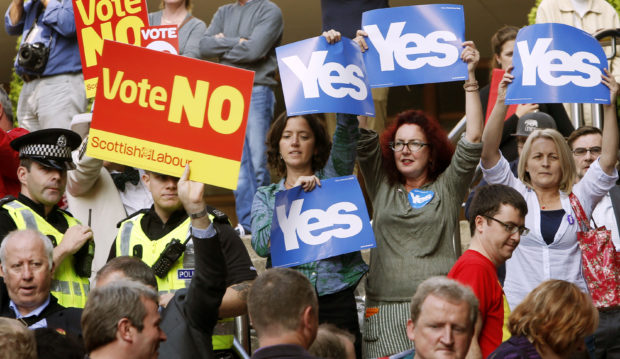
Love is not a word you often hear in politics. In part, I think, because love is seen as something too soft. But a politics of love demands more than just a series of saccharine-sweet soundbites, more than the woolly warm wishes you might expect in a Christmas card greeting.
As we know from our own lives, love is sometimes something difficult, something that challenges us to change at the deepest level because it asks us to rise above what might be “best for me” to what is “best for all of us”.
I first encountered the idea of a politics of love in North America, as people there tried to work out how best to respond to Donald Trump and his politics of fear, his politics of them and us, finger-pointing, name-calling, soul-destroying division.
We are fortunate in Scotland and the UK that our politics has not plumbed Trumpian depths but that does not mean we are dealing with big decisions, and genuine differences, particularly well.
It too often feels that in the debate about independence, for example, we have two sides talking at each other and over each other. There is a lot of heat and not always very much light.
Might love, therefore, with its invitation to build relationships, better understand each other, and rise above our own self-interest, be part of a different way forward in the coming year? Might it help us find a path that is more unifying, and set us up for what comes next in the best possible way?
In the new year, we begin a period with various silver anniversary celebrations for devolution. For example, it will be a quarter of a century since the legislation that created the Scottish Parliament was passed at Westminster.
I say this because 25 years is a good moment to stop and reflect on the journey so far – including its beginnings. Indeed, the way we came together to produce the blueprints for our new parliament offers important lessons for how we might decide, today, our country’s next steps.
The hope back then was that the Scottish Parliament would help deliver a “new politics” in Scotland. In fact, this different way of doing politics was one of the key promises of devolution, important enough to feature on the campaign leaflets of the Yes, Yes campaign.
It was a promise made for two reasons. First, people were genuinely tired of the “winner-takes-all” mindset of Westminster. As the Scottish Constitutional Convention – a body made up of politicians and representatives of wider, civic Scotland – described it, Scotland’s parliament was to offer something “radically different from the rituals of Westminster: more participative, more creative, less needlessly confrontational”.
Second, and perhaps more importantly, the experience of working together to agree the blueprint for devolution – across party lines and with strong, influential voices from outside politics – had persuaded members of the convention that new politics was also better politics.
In the convention, no major decision was ever imposed by a majority vote; there was discussion and then agreement. It was not the quickest or easiest method but it was a process that gave those involved a “mutual understanding and respect” which, as they wrote, “afforded us, too, the vision of a new kind of politics, one in which we have come to see great value”.
The Labour Party, in particular, made some big concessions, above all over the voting system. The fairer voting system we have today meant Labour lost influence but they chose to put the national interest before a narrower political self-interest. I think Scotland is better because of it, and our parliament too, while not perfect by any means, is also better as a result.
This “new politics” is, I believe, a very Scottish example of a politics of love, of trying to put the needs of all of us before the rights of just some of us. It is very much part of who we are, of the founding DNA of our parliament. It was our answer to an old binary – the Westminster binary – and it offers valuable lessons as we seek to work through a new binary in Scotland, between Yes and No, between independence and staying as part of the UK.
It was ordinary Scots who created the Constitutional Convention and put pressure on the politicians to take the conversation about Scotland’s future into this more consensual environment.
The result was a process that gave us space and time to work out what it was we really wanted. We had a referendum, but only after a process of genuine engagement and discussion, after a process that was unifying and identified Scotland’s settled will. A quarter of a century on, we have it in us to do the same.
Stephen Noon is former chief strategist for Yes Scotland in the 2014 referendum.

Enjoy the convenience of having The Sunday Post delivered as a digital ePaper straight to your smartphone, tablet or computer.
Subscribe for only £5.49 a month and enjoy all the benefits of the printed paper as a digital replica.
Subscribe